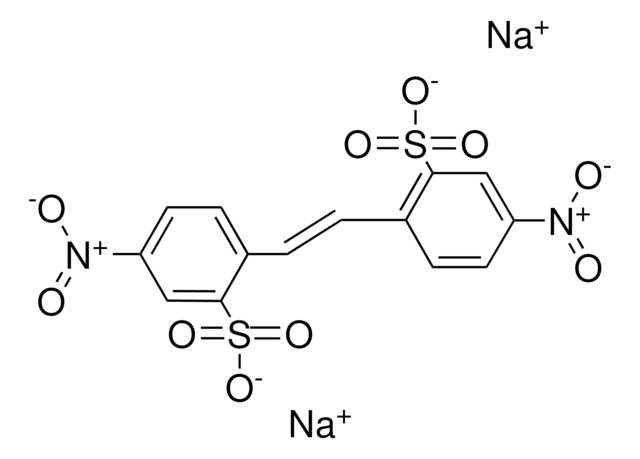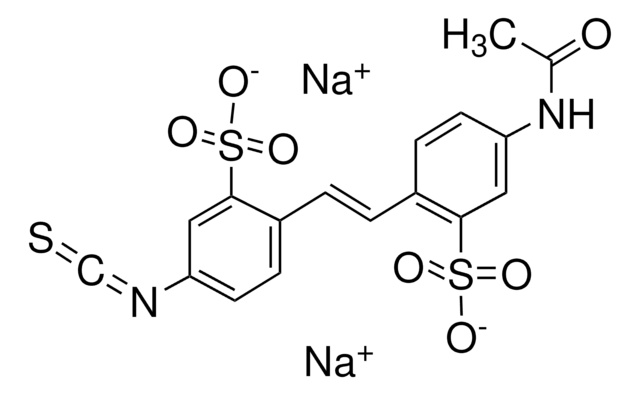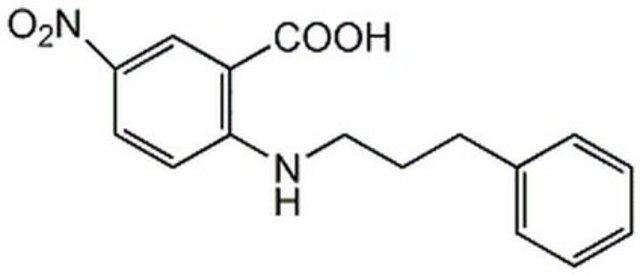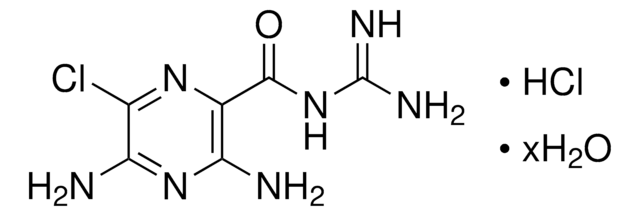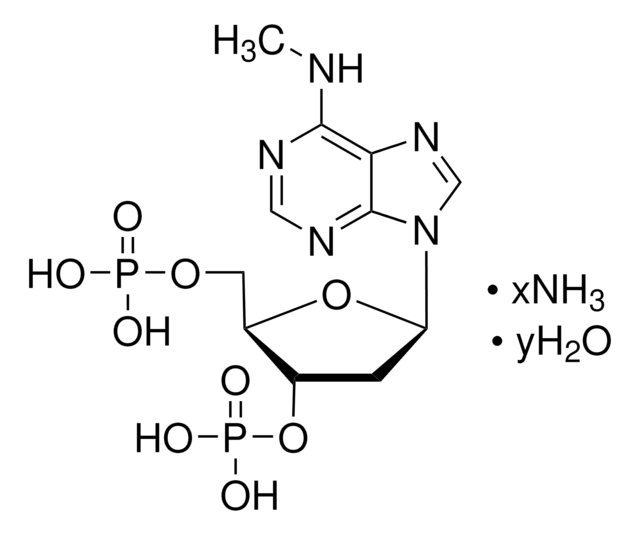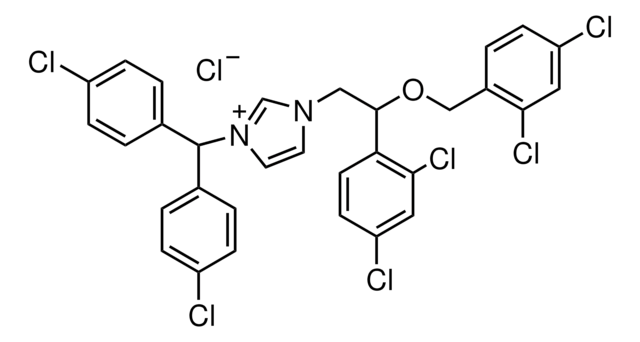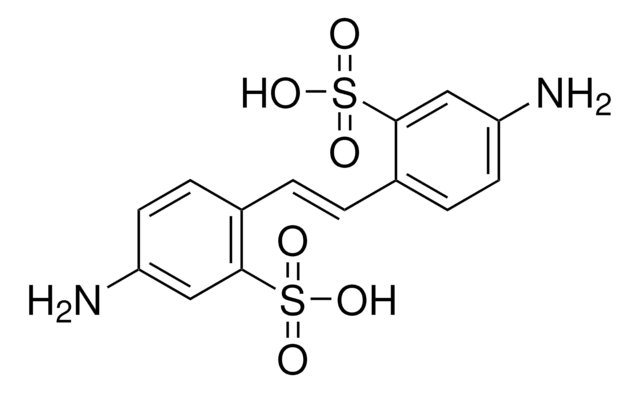D3514
4,4′-Diisothiocyanatostilbene-2,2′-disulfonic acid disodium salt hydrate
≥80% (elemental analysis), powder
Synonym(s):
DIDS, Disodium 4,4′-diisothiocyanatostilbene-2,2′-disulfonate
About This Item
Recommended Products
Assay
≥80% (elemental analysis)
form
powder
reaction suitability
reagent type: cross-linking reagent
color
yellow
solubility
0.1 M potassium bicarbonate: 50 mg/mL
storage temp.
2-8°C
SMILES string
[Na+].[Na+].[O-]S(=O)(=O)c1cc(ccc1\C=C\c2ccc(cc2S([O-])(=O)=O)N=C=S)N=C=S
InChI
1S/C16H10N2O6S4.2Na/c19-27(20,21)15-7-13(17-9-25)5-3-11(15)1-2-12-4-6-14(18-10-26)8-16(12)28(22,23)24;;/h1-8H,(H,19,20,21)(H,22,23,24);;/q;2*+1/p-2/b2-1+;;
InChI key
GEPAYBXVXXBSKP-SEPHDYHBSA-L
Looking for similar products? Visit Product Comparison Guide
Application
- as band3 protein inhibitor in rabbits(19)
- for the inhibition of bicarbonate transporters in brain slice tissue(20)
- as HCO3-/Cl- exchanger (anion exchanger) in embryos(21)
Biochem/physiol Actions
Signal Word
Danger
Hazard Statements
Precautionary Statements
Hazard Classifications
Eye Irrit. 2 - Resp. Sens. 1 - Skin Irrit. 2 - STOT SE 3
Target Organs
Respiratory system
Storage Class Code
11 - Combustible Solids
WGK
WGK 3
Flash Point(F)
Not applicable
Flash Point(C)
Not applicable
Personal Protective Equipment
Choose from one of the most recent versions:
Already Own This Product?
Find documentation for the products that you have recently purchased in the Document Library.
How does the storage temperature relate to shipping conditions?
The storage conditions that a Sigma-Aldrich catalog and label recommend for products are deliberately conservative. For many products, long-term storage at low temperatures will increase the time during which they are expected to remain in specification and therefore are labeled accordingly. Where short-term storage, shipping time frame, or exposure to conditions other than those recommended for long-term storage will not affect product quality, Sigma-Aldrich will ship at ambient temperature. The products sensitive to short-term exposure to conditions other than their recommended long-term storage are shipped on wet or dry ice. Ambient temperature shipping helps to control shipping costs for our customers. At any time, our customers can request wet- or dry-ice shipment, but the special handling is at customer expense if our product history indicates that the product is stable for regular shipment. See Shipping and Storage for more information.
Which document(s) contains shelf-life or expiration date information for a given product?
If available for a given product, the recommended re-test date or the expiration date can be found on the Certificate of Analysis.
How do I get lot-specific information or a Certificate of Analysis?
The lot specific COA document can be found by entering the lot number above under the "Documents" section.
How do I find price and availability?
There are several ways to find pricing and availability for our products. Once you log onto our website, you will find the price and availability displayed on the product detail page. You can contact any of our Customer Sales and Service offices to receive a quote. USA customers: 1-800-325-3010 or view local office numbers.
What is the Department of Transportation shipping information for this product?
Transportation information can be found in Section 14 of the product's (M)SDS.To access the shipping information for this material, use the link on the product detail page for the product.
What is the solubility of 4,4´-Diisothiocyanatostilbene-2,2´-disulfonic acid disodium salt (Product No. D3514)?
Product No. D3514 is soluble in 0.1 M KHCO3 (50 mg/mL) yielding a hazy, yellow-green solution. This may require heat for complete solubilization. DIDS is also soluble in DMSO.
What is the solution stability of 4,4´-Diisothiocyanatostilbene-2,2´-disulfonic acid disodium salt (Product No. D3514)?
We have no specific solution stability data for Product No. D3514, however, isothiocyanates are unstable in water and should not be stored in aqueous solutions.
What are the fluorescent properties of 4,4´-Diisothiocyanatostilbene-2,2´-disulfonic acid disodium salt (Product No. D3514)?
Product No. D3514 has an excitation maximum at a wavelength of 342 nm, and an emission maximum at a wavelength of 418 nm, measured in water.
Is there a reference for the use of 4,4´-Diisothiocyanatostilbene-2,2´-disulfonic acid disodium salt (Product No. D3514) as a cross-linking reagent?
The spectral properties of Product No. D3514 are: ?max: 220 nm, 265 nmExtinction coefficient: EmM = 3000 (280 nm, water), EmM = 54 (342 nm, water). This information is from J. Membrane Biol., 29, 147-177 (1976).
Is there a reference for the use of 4,4´-Diisothiocyanatostilbene-2,2´-disulfonic acid disodium salt (Product No. D3514) as a cross-linking reagent?
Product No. D3514 binds covalently (irreversibly) to the outer surface of human erythrocyte membrane protein, functioning as an anion transport inhibitor. It also can be used to cross-link membrane anion transport sites. A good cross-linking reference is J. Membrane Biol., 29, 147-177 (1976).
My question is not addressed here, how can I contact Technical Service for assistance?
Ask a Scientist here.
Our team of scientists has experience in all areas of research including Life Science, Material Science, Chemical Synthesis, Chromatography, Analytical and many others.
Contact Technical Service
